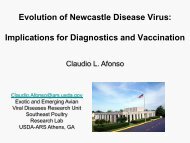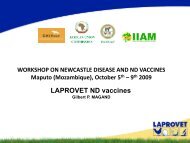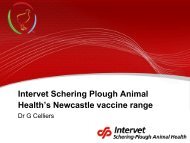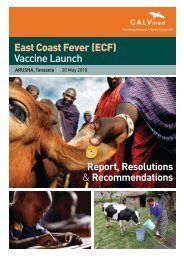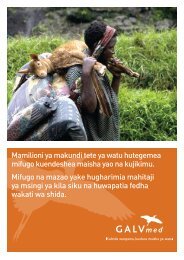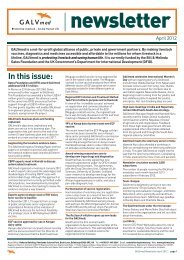A Path to Prosperity New Directions for African Livestock
GALVmed Impetus Strategy Paper
GALVmed Impetus Strategy Paper
- No tags were found...
You also want an ePaper? Increase the reach of your titles
YUMPU automatically turns print PDFs into web optimized ePapers that Google loves.
1 a Regional Committee <strong>for</strong> Veterinary Medicinal<br />
Products (CRMV)<br />
The CRMV meets on an ad hoc basis <strong>to</strong> review<br />
registration dossiers. The committee comprises<br />
scientists recruited <strong>for</strong> their personal<br />
competence. It is supported by a Permanent<br />
Secretariat, housed at the UEMOA headquarters.<br />
The CRMV is backed up by UEMOA regulations<br />
that define the minimum requirements that<br />
must be applied by member countries <strong>for</strong> the<br />
production, importation, quality control and<br />
operation of veterinary pharmaceutical<br />
establishments, plus the marketing and<br />
distribution of veterinary medicinal products<br />
in the UEMOA region.<br />
2 a Veterinary Committee of CVOs<br />
The committee’s duties are broader than drug<br />
legislation. It also handles areas of lives<strong>to</strong>ck<br />
production where a regional approach shows<br />
clear benefits eg. animal health, safety of<br />
foodstuffs of animal origin, veterinary practice<br />
and animal welfare.<br />
3 a network of labora<strong>to</strong>ries <strong>to</strong> carry out<br />
quality testing<br />
Nine labora<strong>to</strong>ries were selected, six <strong>to</strong> analyse<br />
pharmaceutical products and three <strong>to</strong> analyse<br />
immunological products.<br />
The WAEMU institutions and appropriate legislation<br />
are now in place and moni<strong>to</strong>ring of their operational<br />
capacity by the veterinary committee, neighbouring<br />
regions and the pharmaceutical industry will no<br />
doubt yield important lessons.<br />
Harmonisation of Registration<br />
of Veterinary Medicines in Europe<br />
The regulation of veterinary medicinal products<br />
within the European Union is based on harmonised<br />
legislation established at European Community<br />
level. This legislative framework covers the<br />
manufacture, authorisation (registration), placing<br />
on the market and subsequent moni<strong>to</strong>ring and<br />
maintenance of products.<br />
For over 20 years, a network of three key bodies<br />
has regulated medicines. These are the national<br />
regula<strong>to</strong>ry authorities of the 27 member states,<br />
the European Medicines Agency (EMEA) based in<br />
London and the European Commission in Brussels.<br />
The harmonised system has several benefits:<br />
1 significant reduction in the time and resources<br />
required <strong>to</strong> obtain and maintain registration<br />
(in multiple countries);<br />
2 a “level playing field,” in terms of the application<br />
of harmonised requirements throughout the<br />
network;<br />
3 improved predictability of both timescales and<br />
requirements <strong>for</strong> authorisation.<br />
Three fundamental principles are required <strong>for</strong> this<br />
network or any other region-wide system <strong>to</strong> operate<br />
successfully:<br />
1 Subsidiarity in terms of pooling legal powers –<br />
which means that the central authority (the<br />
European Commission) should only per<strong>for</strong>m<br />
those tasks which cannot be per<strong>for</strong>med<br />
effectively at national level. This allows national<br />
differences <strong>to</strong> be accommodated.<br />
2 A robust system of mutual recognition <strong>to</strong> prevent<br />
duplication of work and maximise the use of<br />
scarce resources (<strong>for</strong> example if a product is<br />
registered in one country and the product owner<br />
wishes <strong>to</strong> register it in a second country).<br />
The owner applies <strong>for</strong> mutual recognition of the<br />
existing registration by the competent authority<br />
of that second country. It is not permissible <strong>to</strong><br />
apply <strong>for</strong> separate registration <strong>for</strong> the same<br />
product in more than one member state. If the<br />
second state does not recognise registration<br />
then there is a time-limited appeals process.<br />
Alternatively, the product owner may wish <strong>to</strong><br />
seek a single authorisation issued by the<br />
European Commission, as this is valid in all<br />
Member States.<br />
3 Mutual trust and transparency is essential if<br />
the network is <strong>to</strong> function rather than merely<br />
exist on paper.<br />
In addition <strong>to</strong> these fundamentals a region requires<br />
the physical and human infrastructure <strong>to</strong> support<br />
the network in terms of places <strong>to</strong> meet, a permanent<br />
secretariat <strong>to</strong> coordinate and ensure the continuity<br />
and quality of the work per<strong>for</strong>med, preferably a<br />
common language and an effective IT system.<br />
Finally you need a common interest in work sharing,<br />
pooling of resources and sovereignty in the interests<br />
of each and every member of the network.<br />
From Mackay D. OIE Conference on veterinary<br />
medicinal products in Africa, 2008 147 .<br />
The Impetus Strategy Paper I Page 64



